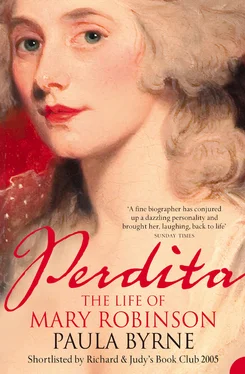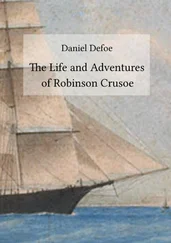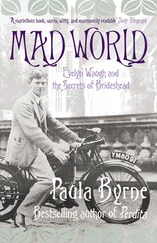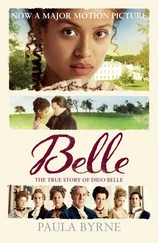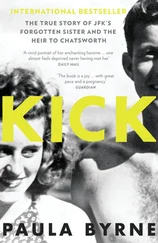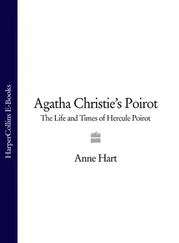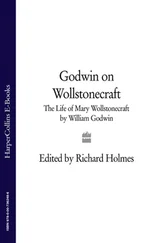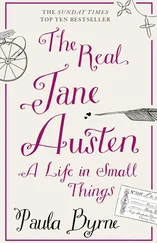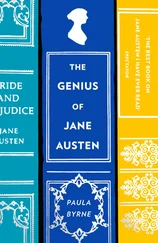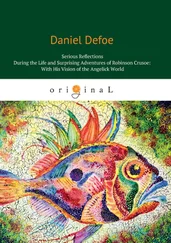Mary often alienated other young women, who were left feeling dowdy and dull in her presence. She was naturally flirtatious and men were captivated by her charm, but she was perhaps less keen to cultivate the friendship of other women, if she did not think it worth her time. She noticed the ‘side-long glances’ of Miss Betsy and Mrs Molly when she entertained visitors who praised her ‘good looks, or taste in the choice of my dresses’. The women taunted her for acting like a duchess with her fine clothes and her accomplishments – ‘a good housewife had no occasion for harpsichords and books’. 17 They reminded her that she had no money to support her fancy ways. But Mary did not care. She had her beauty and her elegance and her humour to protect her. When she went riding with Miss Betsy, she laughed at her odd appearance: ‘Miss Robinson rode on horseback in a camlet safe-guard, with a high-crowned bonnet. I wore a fashionable habit, and looked like something human.’ 18
More disturbingly, Harris seemed to have fallen in love with her even though in his sixties he was old enough to be her grandfather. When he declared that he should ‘have liked me for a wife, had I not married Tom ’, she decided it would be prudent to leave. She feared that ‘through the machinations of Miss Betsy and Mrs Molly I should lose the share I had gained in his affections’. Betsy and Molly were duly furious when the squire insisted upon accompanying Mary to Bristol: ‘he swore that he would see me safe across the Channel, whatever might be the consequences of his journey’. 19
In Bristol, meeting the charming Hester and getting a taste of her active social life, Harris decided to stay a while. Hester introduced him to her friends and he was invited to several dinner parties. Mary danced with him and, after he had supped his evening draught, she would sing to him. He was flattered by the attention and dropped hints to the effect that Tom would inherit the estate. He asked for advice on refurbishments for Tregunter House, and together they picked out smart marble chimney-pieces: ‘Choose them as you like them, Mrs Robinson, for they are all for you and Tom when I am no more.’ 20
* He later changed his name to Hanway Hanway. He was related to philanthropist Jonas Hanway, who campaigned against boy chimney sweeps and was one of the first men to carry an umbrella.
* He later changed his name to Hanway Hanway. He was related to philanthropist Jonas Hanway, who campaigned against boy chimney sweeps and was one of the first men to carry an umbrella.
The town still full of alluring scenes, faro tables, assemblies, to say nothing of Ranelagh, the opening beauties of Kensington, and the morning lounge of St James’s street.
Mary Robinson, The Widow
We are taught to cherish deceit, indifference, vanity, contempt, and scorn; we cannot bear neglect, because it awakens our self-love; we think not of the natural fickleness of man; but we tremble, lest the world should suppose, that a husband’s infidelity proceeds from our own want of attractions to hold him faithful.
Mary Robinson, The False Friend
As soon as Harris had left Bristol, the Robinsons set out for London. According to Mary, they adopted young George Darby and brought him up as their own, until he was old enough to be sent abroad to a merchant house, like his elder brother, John. Elated by the great expectations that Harris had held out for them, the Robinsons threw themselves into London life. The first step they took was to move to a newly built house in Hatton Garden, a location in the ‘city’ at the east end of London as opposed to the more fashionable ‘town’ (or ton ) in the west end. Close to Smithfield Market and St Paul’s, the Hatton Garden district was home to newly prosperous merchants and Jewish moneylenders, jewellers, and lawyers – it was conveniently placed for the Inns of Court.
The Robinsons furnished their new property lavishly and bought a phaeton, the modish open-top carriage that was the same kind of status symbol as a modern convertible. Thomas Robinson also got to know the local jewellers and silversmiths. He bought his wife an expensive watch, enamelled with musical trophies.
From where did they get the money? In her Memoirs Mary claimed ignorance about her husband’s financial affairs and debts (which she always described as his debts rather than hers), but according to King she devised a scheme – played out by Robinson and a group of fellow swindlers – that involved raising ‘immense Quantities of Goods on the Credit of foreign Letters, which they had transmitted them for the Purpose, from Holland, Ostend and France’. 1 Whatever the truth of this allegation, the handsome house in Hatton Garden would have been enough to persuade traders and lenders that the Robinsons’ credit was good.
With a smart address, a flashy phaeton, and Mary’s dazzling good looks, they burst upon the social scene, determined to get themselves noticed. Mary knew how to use her sex appeal: ‘A new face, a young person dressed with peculiar but simple elegance, was sure to attract attention at places of public entertainment.’ 2 She describes her entrance into society as making her debut ‘in the broad hemisphere of fashionable folly’. She might have lost her chance to perform at Drury Lane, but she saw the metropolis as a great urban stage where she could still be a star.
Her first stop was the pleasure gardens at Ranelagh. Pleasure gardens ranked high in London’s recreational activities, but the two most popular were those of Ranelagh in Chelsea and Vauxhall in Lambeth. Here, in the open air, people gathered to stroll, chat, and listen to music. By day they could walk amongst the grottoes, groves, and waterfalls, and by night look at the brilliant lights strewn in the trees, attend concerts, balls and masquerades, and see the fireworks. Ranelagh was the classier venue: at two shillings and sixpence, its entrance fee was more than twice that of raucous Vauxhall. It had Chinese buildings, temples, statues, a canal, and a bridge. It also boasted the rotunda, an enormous circular hall for concerts, ringed with fifty-two boxes. An orchestra played whilst the ladies and gentlemen strolled around the main floor. Regular concerts were held in the summer; the 8-year-old Mozart performed there in 1764. After the concert, one would sit and eat a light supper. It was a place to be noticed and to join the smart set. The royal princes were known to frequent the pleasure gardens with their aristocratic friends. Women of fashion promenaded the main walks to show off their latest gowns and hats, and to make a stir. Prostitutes, dressed in their finery, plied their trade in the wooded groves. In Fanny Burney’s novel Evelina , the innocent heroine mistakes the Ranelagh prostitutes for ladies of fashion and is herself mistaken for a whore when she wanders onto a wrong path.
Mary chose her outfit carefully. She wore a simple Quaker-style, light brown silk dress, with close cuffs. Breaking with the convention of powdering her hair, she perched a plain round cap and a white chip hat on her tumbling auburn locks. She wore no other accessories – no jewellery and no ornaments. She was simplicity itself. Never one to follow fashion slavishly, she had confidence in her individual style and panache. Needless to say, she cut a figure: all eyes were fixed upon her.
The Robinsons’ next outing was to the indoor equivalent of Ranelagh, the Pantheon in Oxford Street. It had only opened a couple of years before, when it was described by Charles Burney as the ‘most elegant structure in Europe, if not on the globe’. 3 In the main it was a musical venue, housing concerts, balls, masquerades, and dances. It also had a central rotunda where visitors could play cards or take supper on ordinary evenings. Tickets for masquerades were expensive and exclusive: by subscription only, at two guineas (the equivalent of about a hundred pounds in today’s money). Mary described it as ‘the most fashionable assemblage of the gay and the distinguished’. As though at court, visitors dressed formally in large hoops and towering headdresses. The women’s hair was raised high with padding and false hair, and then greased with pomade before being powdered. Mary spent hours preparing herself, wearing an exquisite gown of pink satin trimmed with sable, and arranging her suit of ‘rich and valuable point lace’, which was given by her mother. By this time, though, she really was pregnant: ‘my shape at that period required some arrangements, owing to the visible increase of my domestic solicitudes’. 4
Читать дальше
